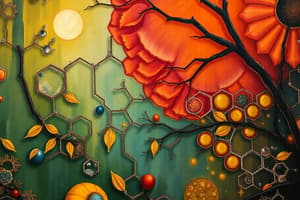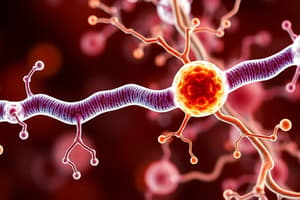Podcast
Questions and Answers
What happens to the activity of glycogen phosphorylase kinase, glycogen phosphorylase, and hormone-sensitive lipase of adipose tissue in their dephosphorylated form?
What happens to the activity of glycogen phosphorylase kinase, glycogen phosphorylase, and hormone-sensitive lipase of adipose tissue in their dephosphorylated form?
- They are activated
- They degrade
- They are inactivated (correct)
- They remain unchanged
What is the role of insulin in enzyme synthesis in the fed state?
What is the role of insulin in enzyme synthesis in the fed state?
- Decrease synthesis of key enzymes
- Increase the synthesis of key enzymes (correct)
- Enhance enzyme degradation
- Activate catabolic enzymes
How do changes in enzyme synthesis affect enzyme molecules according to the text?
How do changes in enzyme synthesis affect enzyme molecules according to the text?
- Increase or decrease the number of enzyme molecules (correct)
- Change their structure
- Alter their stability
- Accelerate their activity
Why does the liver become a net consumer of glucose after a meal containing carbohydrates?
Why does the liver become a net consumer of glucose after a meal containing carbohydrates?
Which mechanism primarily involves the regulation of enzyme synthesis through transcription?
Which mechanism primarily involves the regulation of enzyme synthesis through transcription?
What allows the liver to process and distribute dietary nutrients effectively?
What allows the liver to process and distribute dietary nutrients effectively?
Which enzyme is allosterically inhibited by fructose 2,6-bisphosphate?
Which enzyme is allosterically inhibited by fructose 2,6-bisphosphate?
In the well-fed state, regulatory mechanisms ensure that available nutrients are captured as which of the following?
In the well-fed state, regulatory mechanisms ensure that available nutrients are captured as which of the following?
Which enzymes are mostly in the dephosphorylated form and active during the absorptive state?
Which enzymes are mostly in the dephosphorylated form and active during the absorptive state?
Which type of modification involves the addition or removal of phosphate groups from specific residues of proteins?
Which type of modification involves the addition or removal of phosphate groups from specific residues of proteins?
Flashcards are hidden until you start studying



